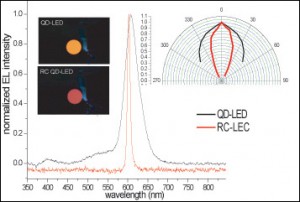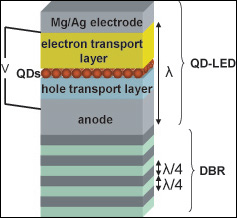Experimental and Theoretical Investigation of Resonant-Cavity Enhanced Colloidal Quantum-dot Light-emitting Diodes
Quantum-dot light-emitting diodes (QD-LEDs), which capitalize on the excellent color saturation and high photoluminescence efficiencies offered by quantum dots (QDs), promise to be part of future generations of display technologies [1]. The goal of our project is to integrate the QD-LED into a resonant cavity (RC) and enhance the intensity and the directionality of the QD electroluminescence (EL) akin to Schubert’s study of RC GaAs LEDs [2]. This enhanced QD emission may be of use in fields as diverse as optical communications, spectroscopy, and environmental and industrial sensing.

Figure 2: Comparison of EL spectra, images, and angular emission profiles of RC QD-LED and QD-LED. The RC QD-LED exhibits marked narrowing.
The RC structure we are currently investigating (Figure 1) consists of a standard QD-LED [1] grown on top of a distributed Bragg reflector (DBR). A DBR is a highly reflective mirror made of alternating layers of material with high and low indices of refraction. The Ag electrode on the top of QD-LED constitutes the other cavity mirror of the resonant cavity. With this structure, we have achieved narrowed emission, which is evident when comparing EL spectra and images of the QD-LED and the RC QD-LED (Figure 2).
To better understand and optimize the device, we are currently modeling the device architecture to simulate the effect of the resonant cavity on the emission of the QD-LED. Our approach builds from first principles, calculating the optical modes of the system to deduce the coupling strength between the vacuum electric field and the QD transition dipole and then applying Fermi’s golden rule to determine the spontaneous emission rate of the QDs.
References
- S. Coe, W. K. Woo, M. Bawendi, and V. Bulović, “Electroluminescence from single monolayers of nanocrystals in molecular organic devices,” Nature, vol. 420, no. 6917, pp. 800-803, Dec. 2002. [↩] [↩]
- E. F. Schubert, N. E. J. Hunt, M. Micovic, R. J. Malik, D. L. Sivco, A. Y. Cho, and G. J. Zydzik, Highly efficient light-emitting diodes with microcavities,” Science, vol 265, no. 5174, pp. 943-945, Aug. 1994. [↩]
